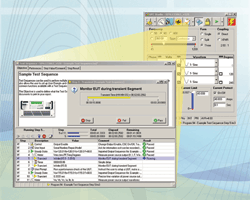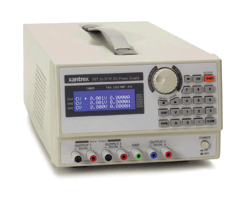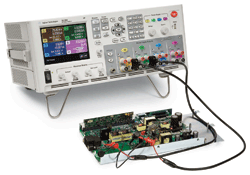Demands for greater simplicity and speed in testing power performance and efficiency are bringing new products to market
By RICHARD COMERFORD
Electronic Products Editor
Power has been an essential element of electrical engineering since the days of Edison and Tesla, so much so that there was a time when it was taken for granted by designers, often being relegated to the last task in the design process. That’s not the case today.
Precise control and efficient use of power is at the heart of practically every commercial and consumer system being designed today. Not only is money power, but with the oil for power utilities costing more than ever before, power is money. And that is also true in a different way for handheld devices: their ability to run for longer times from batteries translates directly into increased sales.
At the same time, characterizing power consumption has become more difficult, with devices exhibiting complex power-on/power-off sequences and a greater need to operate reliably under widely varying power conditions. And along with this increased test demand comes manufacturing’s plea to speed testing so products can move more quickly down the line and into end-users’ hands. Thus suppliers of power equipment for test are looking for ways to make their engineering customers lives easier.
Gaining control
The most recent example of this trend comes from Pacific Power Source (www.pacificpower.com). In Version 1.3 of its UPC Studio Software, a tool designed to give users exceptional control of the company’s UPC-equipped ac power sources, Pacific Power has incorporated a unique feature called Test Manager.
Test Manager helps designers quickly create and run Test Sequences and Test Plans that can be used both in the design stage and released to manufacturing with the final design. Test Sequences consist of one or more output sequences (see Fig. 1 ), which are designed to execute a series of automated tasks that control and monitor the ac power source and other instruments from the power source itself. Test results are then stored in user-defined test reports.
Test Plans manage and simplify complex tasks by letting users link together a series of Test Sequences into a single test.

Fig. 1. Test Manager lets users create complex test sequences and organize them into plans through UPC Studio’s graphical interface.
The Test Manager lets users tie together output sequences with prompts, user controls, Visual Basic scripts, meter controls, and more. This gives the operator full control and definability of complete Test Plans and reports, versus just controlling the ac power source. And it so doing, the software saves time and money by allowing test engineers to quickly and easily generate complete test routines.
With Test Manager, the user can automate instrument compliance testing and certification as well as obtain pre-configured Test Sequences and Test Plans from Pacific Power Source. Typical Test Sequences include DO-160 and MIL-STD-704 for avionics compliance testing.
These Test Manager features serve to complement the level of control enjoyed in the previous version of UPC Studio. The detailed Waveform Editor, the ability to measure and graph voltage and current harmonics to customer-specified limits, and the precise control of Transients within Output Sequences still remain powerful and essential tools.
Test Manager is controlled through UPC Studio, which provides a graphical interface for the ac power source. It includes safeguards to protect the Equipment Under Test (EUT) and guides the user into entering values appropriate for the power source.
In addition to controlling the ac power source and monitoring the output, UPC Studio can be used to generate and view “offline” simulation files. This detailed view provides the ability to observe the steady-state waveform and programmed transient before power is applied to the EUT.
UPC Studio including UPC Control and UPC Manager with Output Sequence Browser is free to customers with registration. Test Manager is currently $1,750, and preconfigured test sequences start at $500.
More flexible
To provide users with greater flexibility in setting up their supplies, Xantrex Technology (www.xantrex.com) is providing a series of triple-output benchtop supplies that lets users set up each output independently. The 222-W linear XBT programmable power supplies suit both laboratory and low power ATE applications.

Fig. 2. Manually or computer controlled, the XBT series provides two 32-V, 3-A and one 15-V, 5-A (30-W limit) independent outputs.
The XBT series provides higher power with two 32-V, 3-A outputs plus one 15-V, 5-A (30-W limit) output, offering more flexibility than typically found in bench top supplies. It is easy to use in both manual and computer-control modes. With direct keypad entry and digital encoder knob control, users can pick their preferred method of control depending on the application or user preference. For computer control, USB and RS-232 are standard while IEEE-488.2/GPIB and Ethernet are optional.
Tester in a box
The first shot in the benchtop power revolution was fired last year by Agilent Technologies with its N6705A DC Power Analyzer (see Fig. 3 ). An Electronic Products ’ Product of the Year award winner, the analyzer turned out to be the most widely acclaimed instrument in the company’s eight-year history.

Fig. 3. The N6705A Dc Power Analyzer turned out to be the most widely acclaimed product in Agilent’s history.
A first-of-its-kind instrument, the analyzer is built around four user-selectable and -confugurable benchtop power supplies to which it adds a DMM, an oscilloscope, an arbitrary waveform generator, and a datalogger. Thus it provides a complete user-configurable benchtop power supply/test system in one box that doesn’t require programming.
The front-panel controls are so easy to use that an operator can set the instrument up without prior training — an aspect that suits the equipment not only for design but for manufacturing and troubleshooting as well. To get a real feel for the power of those controls, readers can find a simulation of the front panel at http://www.home.agilent.com/agilent/redirector.jspx?action=ref&lc=eng&cc=US&nfr=-11143.0.00&ckey=1174062&cname=AGILENT_EDITORIAL ■
Advertisement
Learn more about Electronic Products Magazine





